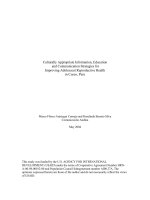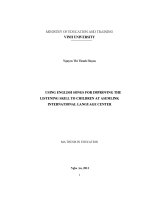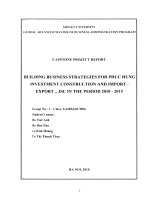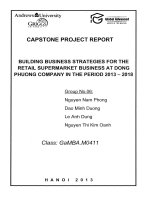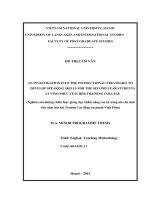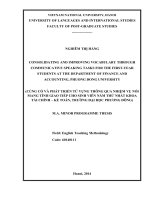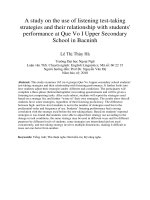Strategies for improving import yard performance at container marine terminals
Bạn đang xem bản rút gọn của tài liệu. Xem và tải ngay bản đầy đủ của tài liệu tại đây (3.66 MB, 172 trang )
PhD Thesis
STRATEGIES FOR IMPROVING IMPORT YARD
PERFORMANCE AT CONTAINER MARINE TERMINALS
Author:
Enrique Martín Alcalde
PhD Supervisor:
Dr. Sergi Saurí Marchán
PhD Program in Civil Engineering
E.T.S. d’Enginyers de Camins, Canals i Ports de Barcelona (ETSECCPB)
Universitat Politècnica de Catalunya–BarcelonaTech (UPC)
Barcelona, May 2014
STRATEGIES FOR IMPROVING IMPORT YARD
PERFORMANCE AT CONTAINER MARINE TERMINALS
Autor:
Enrique Martín Alcalde
Director de la tesi:
Dr. Sergi Saurí Marchán
Memòria presentada per optar
al títol de Doctor Enginyer de Camins, Canals i Ports
E.T.S. d’Enginyers de Camins, Canals i Ports de Barcelona (ETSECCPB)
Universitat Politècnica de Catalunya –BarcelonaTech (UPC)
Barcelona, Maig 2014
To my parents, Enrique and Aurora
and to my brothers, Alberto and Carlos
(…) In 1956, China was not the world’s workshop. It was not routine for shoppers to find
Brazilian shoes and Mexican vacuum cleaners in stores in the middle of Kansas. Japanese
families did not eat beef from cattle raised in Wyoming, and French clothing designers did not
have their exclusive apparel cut and sewn in Turkey or Vietnam. Before the container,
transporting goods was expensive, so expensive that it did no pay to ship many things halfway
across the country, much less halfway around the world.
The Box: how the shipping container made the world smaller and the world economy bigger.
Marc Levinson (2006). Princeton University Press, New Jersey.
Abstract
STRATEGIES FOR IMPROVING IMPORT YARD PERFORMANCE AT
CONTAINER MARINE TERMINALS
Enrique Martín Alcalde
Abstract
The process of containerization and its continuous development involves changes and
technological innovations in containerships and maritime container terminals. In the
current era of “gigantism”, despite existing fleet overcapacity, shipping companies are
booking larger and fuel-efficient vessels to benefit from economies of scale and to
reduce operating costs. Consequently, port terminals have to cope with unprecedented
container volumes and increasing demands, as a result, handling operations are likely to
be subject to delay.
In this context, container terminals are dealing with the huge challenge of readjusting
themselves in order to, on one hand, improve productivity and level of service offered
to the customers (minimize turnaround time) and, on the other hand, to manage terminal
handling operations efficiently with the aim of reducing operating costs and becoming
more competitive.
Moreover, considering that adapting facilities and terminal infrastructures involves large
investment and given the lack of space in many urban ports for expanding the
operational area, the improvement of handling operations efficiency is more important
than ever. Thus, many efforts are required to improve the productivity of container
terminals by introducing efficient solutions and optimization techniques to decisionmaking processes and, on the other side, introducing technological improvements such
as the automation of handling equipment.
In light of this, this thesis is focused on the optimization of handling operations in the
storage yard, which is considered to be the most complex terminal subsystem since
terminal performance depends on its efficiency.
In particular, it attempts to: (1) determine optimal storage space utilization by
considering the yard inventory and congestion effects on terminal performance; (2)
introduce new allocating storage strategies with the aim of minimizing the amount of
rehandling moves, which are considered to be the most important cause of inefficiency
in container yard terminals, and; (3) develop a generic storage pricing schedule to
encourage customers to pick up their containers promptly and, as a consequence, reduce
the average duration of stay, avoiding yard congestion.
In order to tackle these issues, two different analytical models are introduced in this
thesis. The first one aims to forecast storage yard inventory by dealing explicitly with
Abstract
stochastic behavior, yard inventory peaks and seasonal fluctuations. The second one,
which is based on probabilistic and statistical functions, is derived to estimate the
average number of rehandles when containers with different departure probabilities are
mixed in the same stack.
Finally, the numerical experiments presented in this thesis prove the usefulness of the
different analytical models, yard design methods, cost models and operative and tactical
strategies developed herein. These can be applied by other researchers, planners and
terminal operators to optimize the yard handling processes, to improve their efficiency
rates and to increase terminal throughput without incurring large investment. By being
technically efficient, the terminal will be more cost-efficient as well, resulting in the
overall optimization of terminal performance.
Keywords: container terminals, yard inventory planning, storage capacity, allocating
strategies, storage pricing schedule, stochastic analysis, rehandling moves, terminal
performance.
Sergi Saurí, Ph.D
Assistant Professor of Transportation
School of Civil Engineering–UPC BarcelonaTech
May, 2014
10
Acknowledgements
Acknowledgements
Atrás queda aquella tarde de viernes, a principios de 2009, cuando decidí afrontar el reto del
doctorado como una meta personal y profesional. Cinco años más tarde, tras una interesante y
fructuosa etapa, me dispongo a expresar mi más sincero agradecimiento a todas aquellas
personas que, de una forma u otra, también son protagonistas de esta tesis.
En primer lugar, me gustaría otorgar un especial merecimiento a mi tutor y director de tesis, Dr.
Sergi Saurí Marchán, por haber apostado y confiado en mí y haberme brindado esta oportunidad.
Sinceramente, muchas gracias por tus consejos, comentarios, revisiones, apoyo y, sobretodo,
por haberme inculcado rigor y auto exigencia en el trabajo. Esto último, es de lo más
significativo que me llevo de esta etapa.
Secondly, I wish to express my deep gratitude to Professor Kap Hwan Kim, my PhD supervisor
during my stay at the Logistics System Laboratory of the Pusan National University in South
Korea, for agreeing to my stay, for his patient guidance, enthusiastic encouragement and useful
critiques of this research work. His willingness to give his time so generously has been very
much appreciated. I would also like to thank all his team (Ivan K., Byeong-Ju, Hak-Bong, Mrs.
Woo, Mrs. Shin and Mrs. Mai-Ha) for their kindness and help provided during my stay. Despite
cultural differences I felt like being part of their family since the first day. To all of them,
“Kamsahamnida”.
En tercer lugar, agradecer al CENIT por darme la oportunidad de poder compaginar la actividad
profesional con el desarrollo de esta tesis y, sobretodo, a mis compañeros y excompañeros
durante estos cinco años. El buen ambiente y compañerismo que se respira en la oficina se debe
a todos y cada uno de vosotros. Por ello, me gustaría dedicar un agradecimiento personal a:
Siscu, Albert, Carles, Mireia, Pilar, Pau, Pablo, Hugo, Marta, Xavi, Josep Maria, Deme, Beti,
Argote, Esther, Eva, Carol, Vero y un largo etcétera. También quisiera dotar un especial
reconocimiento a Jordi Salvador y Jordi Serra, compañeros de batalla y coautores de alguno de
los artículos que derivan de esta tesis.
En cuarto puesto, quisiera agradecer muy especialmente a mis padres y hermanos por el apoyo
anímico y continuo respaldo. Gracias por estar siempre ahí y haber consolidado ese núcleo
familiar tan importante para mí. También hacer extensivas mis muestras de agradecimiento a
mis abuelos, a la familia Rovira-Estil·les, a mi gran amigo y “hermano” Valero; a Javi (por tus
buenos consejos); a Irene, por haberme acompañado y alentado durante la última etapa; a mis
amigos de Tarragona; y a otros compañeros y amigos de carrera, colegio mayor, Erasmus y
demás, que poco o mucho, siempre os habéis interesado por el desarrollo de esta tesis.
Acknowledgements
Finalmente, también quisiera agradecer al “Col·legi de Camins, Canals i Ports de Catalunya” y
al “National Research Fundation of Korea (NRF)” por haberme facilitado ayuda económica en
la matrícula del curso académico 2012-2013 y durante mi estancia en Busan, respectivamente.
Sinceramente, muchísimas gracias por todo.
Barcelona, 5 de mayo de 2014
12
Table of contents
Table of contents
ABSTRACT9
ACKNOWLEDGEMENTS
1.
INTRODUCTION, OBJECTIVES AND CONTRIBUTIONS ....................................... 1
1.1
BACKGROUND AND OBJECTIVES ................................................................................... 1
1.2
TERMINAL OPERATIONS AND PORT CONTAINER TERMINALS ........................................ 3
1.2.1 Container terminal operations .................................................................................. 3
1.2.2 Layout of container terminals ................................................................................... 5
1.2.3 Planning problems and decision making levels in container terminals .................... 6
1.3
RESEARCH SCOPE OF THE THESIS .................................................................................. 7
1.4
MAIN CONTRIBUTIONS OF THE THESIS .......................................................................... 9
1.5
PUBLICATIONS FROM THIS THESIS ............................................................................... 11
1.6
OUTLINE OF THE THESIS .............................................................................................. 11
2.
LITERATURE REVIEW ................................................................................................. 13
2.1
OVERVIEW ................................................................................................................... 13
2.2
STORAGE YARD PLANNING AND DESIGN ..................................................................... 13
2.3
STORAGE SPACE ALLOCATION PROBLEM .................................................................... 16
2.3.1 Space allocation problem for inbound containers .................................................. 16
2.3.2 Space allocation problem for outbound and transshipment containers .................. 18
2.4
STORAGE PRICING STRATEGIES ................................................................................... 22
2.5
SUMMARY AND CONTRIBUTIONS................................................................................. 25
2.5.1 Storage yard planning and design........................................................................... 25
2.5.2 Storage space allocation for inbound containers.................................................... 25
2.5.3 Storage pricing strategies for the storage of containers ......................................... 26
3. AN ANALYTICAL MODEL TO FORECAST YARD INVENTORY IN
CONTAINER TERMINALS ................................................................................................... 29
3.1
INTRODUCTION ............................................................................................................ 29
3.2
ESTIMATION OF THE CONTAINER YARD INVENTORY ................................................... 30
3.2.1 Assumptions and notation ....................................................................................... 30
3.3
SPACE REQUIREMENT ASSOCIATED TO A SINGLE VESSEL ........................................... 31
3.3.1 Inbound containers .................................................................................................. 31
3.3.2 Outbound containers ............................................................................................... 33
3.3.3 Transshipment containers ....................................................................................... 34
3.3.4 Total amount of containers related to a single vessel ............................................. 36
xiii
Table of contents
3.4
TOTAL STORAGE SPACE REQUIREMENT ....................................................................... 36
3.4.1 Inbound containers .................................................................................................. 37
3.4.2 Outbound containers ............................................................................................... 37
3.4.3 Transshipment containers ....................................................................................... 38
3.4.4 Total amount of containers ..................................................................................... 38
3.5
NUMERICAL EXPERIMENTS.......................................................................................... 38
3.5.1 Discussions on practical considerations ................................................................. 41
3.6
ANALYSIS OF EXTREME INVENTORY VALUES ............................................................. 42
3.6.1 Fitting procedure of inventory extreme values........................................................ 43
3.7
CONCLUSIONS ............................................................................................................. 47
4. DETERMINATION OF THE OPTIMAL STORAGE CAPACITY FOR EFFICIENT
TERMINAL PERFORMANCE .............................................................................................. 49
4.1
INTRODUCTION ............................................................................................................ 49
4.2
OPTIMAL STORAGE SPACE UTILIZATION ..................................................................... 50
4.2.1 Effects of storage space utilization on terminal performance ................................. 50
4.2.2 Methodology ............................................................................................................ 51
4.3
NUMERICAL STUDY ..................................................................................................... 59
4.3.1 Results ..................................................................................................................... 59
4.3.2 Further numerical experiments ............................................................................... 65
4.4
CONCLUSIONS ............................................................................................................. 66
5. SPACE ALLOCATING STRATEGIES FOR IMPROVING IMPORT YARD
PERFORMANCE ..................................................................................................................... 69
5.1
INTRODUCTION ............................................................................................................ 69
5.2
IMPORT STORAGE STRATEGIES .................................................................................... 70
5.2.1 Overview ................................................................................................................. 70
5.2.2 Strategies ................................................................................................................. 71
5.3
MODEL DEVELOPMENT ................................................................................................ 75
5.3.1 Assumptions and notations ...................................................................................... 75
5.3.2 The model ................................................................................................................ 77
5.4
NUMERICAL CASE ........................................................................................................ 86
5.4.1 Input data ................................................................................................................ 86
5.4.2 Results ..................................................................................................................... 87
5.4.3 Discussion ............................................................................................................... 93
5.5
CONCLUSIONS ............................................................................................................. 94
FOREWORD OF CHAPTERS 6 AND 7 ................................................................................ 97
6. PRICING STORAGE STRATEGIES FOR IMPROVING STORAGE YARD
PERFORMANCE: DETERMINISTIC APPROACH........................................................... 99
6.1
6.2
6.3
INTRODUCTION ............................................................................................................ 99
PROBLEM DESCRIPTION ............................................................................................. 101
ANALYTICAL MODEL TO ESTIMATE IMPORT YARD INVENTORY WHEN A STORAGE
PRICING IS INTRODUCED: DETERMINISTIC APPROACH ........................................................... 103
6.3.1 Problem statement and assumptions ..................................................................... 103
6.3.2 Customers’ choice ................................................................................................. 105
Rescheduling of pick-up decisions for customers storing off-dock ................................... 106
6.3.3 Timing of the cargo stored in the terminal ............................................................ 107
xiv
Table of contents
6.4
OBJECTIVE FUNCTION: MAXIMIZING TERMINAL OPERATOR PROFIT ......................... 109
6.4.1 Simplified cost model for yard operations ............................................................ 109
6.4.2 Revenues of terminal operator .............................................................................. 110
6.4.3 Solution procedure ................................................................................................ 111
6.5
NUMERICAL CASE STUDY .......................................................................................... 111
6.5.1 Baseline scenario .................................................................................................. 111
6.5.2 Sensitivity analysis ................................................................................................ 113
6.6
CONCLUSIONS ........................................................................................................... 114
7. PRICING STORAGE STRATEGIES FOR IMPROVING STORAGE YARD
PERFORMANCE: STOCHASTIC APPROACH ............................................................... 115
OVERVIEW ................................................................................................................. 115
ANALYTICAL MODEL TO ESTIMATE IMPORT YARD INVENTORY WHEN A STORAGE
PRICING IS INTRODUCED: STOCHASTIC APPROACH ................................................................ 115
7.2.1 Main assumptions.................................................................................................. 115
7.2.2 Number of inbound containers at the storage yard ............................................... 117
7.3
STORAGE PRICING OPTIMIZING MODELS ................................................................... 120
7.3.1 Cost model of the terminal operator ..................................................................... 120
7.3.2 External cost of container terminals ..................................................................... 123
7.3.3 Customers’ expenses to move containers to the off-dock warehouse.................... 124
7.3.4 Revenues of the terminal operator ........................................................................ 125
7.3.5 Objective functions ................................................................................................ 125
7.3.6 Solution procedure ................................................................................................ 127
7.4
NUMERICAL EXPERIMENTS........................................................................................ 128
7.4.1 Results and sensitivity analysis ............................................................................. 128
7.5
DISCUSSIONS AND COMPARISON BETWEEN THE DETERMINISTIC AND THE STOCHASTIC
APPROACH ............................................................................................................................. 133
7.6
CONCLUSIONS ........................................................................................................... 134
7.1
7.2
8.
CONCLUSIONS AND FUTURE RESEARCH ........................................................... 135
8.1
OVERVIEW ................................................................................................................. 135
8.2
MAIN FINDINGS AND CONCLUSIONS .......................................................................... 136
8.2.1 Summary ................................................................................................................ 139
8.3
FUTURE RESEARCH .................................................................................................... 140
APPENDIX A: FORMULATION ......................................................................................... 141
APPENDIX B: ABBREVIATIONS ....................................................................................... 145
REFERENCES ........................................................................................................................ 147
xv
Table of contents
xvi
List of figures
List of figures
FIGURE 1.1: CONTAINER TERMINAL DIVIDED INTO THE MAIN SUBSYSTEMS. SOURCE: HENESEY,
2004. ...................................................................................................................................... 3
FIGURE 1.2: AN ILLUSTRATION OF A CONTAINER TERMINAL WITH A PERPENDICULAR LAYOUT
AND BLOCK DETAIL. .............................................................................................................. 6
FIGURE 1.3: GENERAL OVERVIEW OF THE THESIS CONTENTS ................................................... 12
FIGURE 3.1: CONTAINER ACCUMULATION AND DISSIPATION PATTERNS FROM THE STORAGE
YARD RELATED TO A SINGLE VESSEL .................................................................................. 30
FIGURE 3.2: STORAGE SPACE REQUIREMENT AND INVENTORY YARD FLUCTUATIONS DURING
AN OPERATING YEAR ........................................................................................................... 39
FIGURE 3.3: STORAGE SPACE REQUIREMENT OVER AN OPERATING YEAR (HISTOGRAM) ......... 40
FIGURE 3.4: COMPARISON OF ESTIMATED YARD INVENTORY AND REAL (SIMULATED) TIME
SERIES. ................................................................................................................................. 41
FIGURE 3.5: INVENTORY PEAKS OVER AN ARBITRARY THRESHOLD (DURING A YEAR) ............ 43
FIGURE 3.6: HISTOGRAM AND EMPIRICAL CDF OF YARD INVENTORY. EXTREME VALUES ARE
PLACED IN THE RIGHT TAIL OF THE DISTRIBUTION. ............................................................. 45
FIGURE 3.7: FIT THRESHOLD RANGES VERSUS SHAPE AND SCALE PARAMETERS STABILITY PLOT.
............................................................................................................................................. 45
FIGURE 3.8: PROBABILITY DENSITY AND CUMULATIVE DISTRIBUTION FUNCTION OF THE
RESULTING GPD (EXPONENTIAL TAIL) ............................................................................... 46
FIGURE 3.9: RETURN LEVEL PLOT FOR YARD INVENTORY AND EXPECTED PEAKS VALUES
ASSOCIATED TO DIFFERENT YEARS ..................................................................................... 47
FIGURE 4.1: STORAGE SPACE UTILIZATION IMPACT ON QC CYCLE TIMES (EMPIRICAL DATA
FROM BUSAN NEWPORT) .................................................................................................... 51
FIGURE 4.2: TRADE-OFF BETWEEN THE SPACE PROVIDED AND RELATED COSTS ...................... 52
FIGURE 4.3: OPTIMAL SPACE UTILIZATION FOR THE IMPORT AREA AND PARALLEL LAYOUT ... 60
FIGURE 4.4: OPTIMAL SPACE UTILIZATION FOR THE EXPORT AND TRANSSHIPMENT AREA AND
PARALLEL LAYOUT .............................................................................................................. 61
FIGURE 4.5: OPTIMAL SPACE UTILIZATION FOR THE IMPORT AREA AND PERPENDICULAR
LAYOUT ............................................................................................................................... 62
FIGURE 4.6: OPTIMAL SPACE UTILIZATION FOR THE EXPORT AND TRANSSHIPMENT AREA AND
PERPENDICULAR LAYOUT .................................................................................................... 63
FIGURE 5.1: GENERAL SCHEME OF STRATEGIES S1 AND S2. ...................................................... 74
FIGURE 5.2: GENERAL SCHEME OF STRATEGY S3. ..................................................................... 75
FIGURE 5.3: DIAGRAM OF ARRIVAL RATES AT THE TERMINAL AND TIME-PLANNING HORIZON.
............................................................................................................................................. 76
FIGURE 5.4: POSSIBLE STACK CONFIGURATION AT
AND
. ..................................... 81
xvii
List of figures
FIGURE 5.5: LAYOUT OF THE IMPORT BLOCK AFTER APPLYING THE DIFFERENT STORAGE
STRATEGIES. STACK CONFIGURATION FOR EACH STRATEGY (SCENARIO (A), T =1.5 AND
H=3). .................................................................................................................................... 88
FIGURE 5.6: INCREASES (%) RELATIVE TO THE AVERAGE NUMBER OF REHANDLES OBTAINED
FOR A HOMOGENEOUS STACK (E[R]=1.25) FOR STRATEGY S1 (SCENARIO (A), T =1.5 AND
H=3 AND H=5). .................................................................................................................... 89
FIGURE 5.7: INCREASES (%) RELATIVE TO THE AVERAGE NUMBER OF REHANDLES OBTAINED
FOR A HOMOGENEOUS STACK (E[R]=4.85) FOR STRATEGY S2 (SCENARIO (A), T =1.5 AND
H=3 AND H=5). .................................................................................................................... 89
FIGURE 5.8: OPTIMUM STRATEGY DEPENDING ON ΔT/E(T) FOR SCENARIO (A) AND A STACKING
HEIGHT OF 3 (H). .................................................................................................................. 90
FIGURE 5.9: OPTIMUM STRATEGY DEPENDING ON ΔT/E(T) FOR SCENARIO (B) AND A STACKING
HEIGHT OF 3 (H). .................................................................................................................. 91
FIGURE 5.10: OPTIMUM STRATEGY DEPENDING ON ΔT/E(T) FOR SCENARIO (A) AND A
STACKING HEIGHT OF 5 (H). ................................................................................................. 91
FIGURE 5.11: OPTIMUM STRATEGY DEPENDING ON ΔT/E(T) FOR SCENARIO (B) AND A
STACKING HEIGHT OF 5 (H). ................................................................................................. 92
FIGURE 6.1: PRICE STORAGE SCHEMES APPLIED BY THE PORT CONTAINER TERMINAL AND OFFDOCK WAREHOUSE. ........................................................................................................... 102
FIGURE 6.2: TERMINAL YARD STORAGE IN A CYCLE OF V=5 UNLOADINGS ............................ 104
FIGURE 6.3: APPROXIMATION OF THE DELIVERY TIMES AFTER THE ITH UNLOADING............. 105
FIGURE 6.4: COST TO CUSTOMERS (PAYING THE TARIFF OR THE WAREHOUSE COST) AND
DEPARTURE DECISIONS ...................................................................................................... 105
FIGURE 6.5: CARGO (FROM THE ITH UNLOADING) STORED IN THE TERMINAL YARD BEFORE (F)
AND AFTER (FΤ) CHARGING A TARIFF. ............................................................................... 108
FIGURE 6.6: FUNCTIONS FOR YARD COSTS .............................................................................. 110
FIGURE 6.7: PROFIT MINUS FIXED COSTS AND ITS DECOMPOSITION. ...................................... 112
FIGURE 7.1: INVENTORY LEVEL OF IMPORT CONTAINERS AT THE STORAGE YARD AND TIMEHORIZON PLANNING........................................................................................................... 116
FIGURE 7.2: INCREASING RATE OF VARIABLE COSTS DUE TO CONGESTION EFFECTS AT THE
YARD ................................................................................................................................. 121
FIGURE 7.3: MAXIMUM EXPECTED PROFITS REGARDING THE THRESHOLD TIME ( ) ............ 129
FIGURE 7.4: EXPECTED TOTAL COSTS REGARDING THE THRESHOLD TIME (TP) ...................... 130
FIGURE 7.5: CHANGE IN THE DECISION VARIABLES A, B, T0 IN RELATION TO THE PROBLEM
WITH RESPECT TO THE STORAGE SPACE UTILIZATION (%) ................................................ 131
FIGURE 7.6: CHANGES IN THE DECISION VARIABLES A, B, T0 OF THE PROBLEM CONCERNING
THE RELATIONSHIP BETWEEN THE OUTCOMING AND INCOMING RATE ............................. 131
FIGURE 7.7: CHANGES IN THE DECISION VARIABLES A, B, T0 FOR THE PROBLEM REGARDING
THE TRANSPORTATION COSTS FROM THE PORT TERMINAL TO THE OFF-DOCK WAREHOUSE
........................................................................................................................................... 132
xviii
List of tables
List of tables
TABLE 1.1: DECISION-MAKING PROBLEMS ANALYZED IN THE THESIS ........................................ 8
TABLE 2.1: SUMMARY OF MAIN STUDIES RELATED TO THE SPACE ALLOCATING PROBLEM FOR
INBOUND CONTAINERS AND CONTRIBUTIONS ..................................................................... 20
TABLE 2.2: SUMMARY OF MAIN STUDIES RELATED TO PRICING STRATEGIES FOR STORAGE AND
CONTRIBUTIONS .................................................................................................................. 24
TABLE 3.1: DEVIATIONS BETWEEN THE PREDICTED AND ANALYTICAL DATA WITH RESPECT THE
VARIABILITY OF INPUT DATA. THE SYMBOL “+++” INDICATES THE HIGHEST VARIABILITY
AND “0” THE DETERMINISTIC CASE. .................................................................................... 42
TABLE 4.1: INPUT DATA RELATED TO UNITARY COSTS AND GEOMETRICAL BLOCK AND AISLES
DATA. ................................................................................................................................... 59
TABLE 4.2: INPUT DATA RELATED TO EXPECTED TIMES OF TERMINAL EQUIPMENT AND
EXTERNAL TRUCKS FOR A BLOCK LAYOUT (34,9,6) ............................................................ 60
TABLE 4.3: OPTIMAL STORAGE SPACE UTILIZATION AND RELATED COSTS FOR THE IMPORT
AREA AND EXPORT AND TRANSSHIPMENT AREA FOR PARALLEL LAYOUT AND L=34; W=9;
H=6...................................................................................................................................... 62
TABLE 4.4: OPTIMAL STORAGE SPACE UTILIZATION AND RELATED COSTS FOR THE IMPORT
AREA AND EXPORT AND TRANSSHIPMENT AREA FOR PERPENDICULAR LAYOUT AND L=34;
W=9; H=6 ............................................................................................................................ 64
TABLE 4.5: SENSITIVITY ANALYSIS RESULTS: OPTIMAL SPACE UTILIZATION AND STORAGE
CAPACITY ............................................................................................................................ 65
TABLE 5.1: STACK CONFIGURATIONS AND CONTAINER COMBINATIONS FOR EACH STRATEGY
AND H=3 .............................................................................................................................. 84
/
ASSUMING SCENARIOS (A) AND
TABLE 5.2: RESULTS OBTAINED FOR PARAMETER
(B) AND H=3......................................................................................................................... 87
/
ASSUMING SCENARIOS (A) AND (B)
TABLE 5.3 RESULTS OBTAINED FOR PARAMETER
AND H=5 .............................................................................................................................. 87
TABLE 5.4: CONTAINER COMBINATION FOR EACH STRATEGY (SCENARIO (A), T =2.0 AND H=3
AND H=5). ............................................................................................................................ 88
TABLE 6.1: IMPORT STORAGE CHARGES AND FREE TIME AT MAJOR CONTAINER TERMINALS
(CHARGE PER TEU) (CMA-CGM, 2012)........................................................................... 100
TABLE 6.2: OPTIMAL YARD TARIFF AND RESULTS FOR THE NUMERICAL EXAMPLE ................ 112
TABLE 6.3: PERCENT DEVIATION WITH REGARD TO BASE SCENARIO (ΔT0=2, Λ0=1/6, CV0=10,
Θ0=1.2NV ) ......................................................................................................................... 113
xix
List of tables
TABLE 7.1: OPTIMAL PARAMETERS, EXPECTED PROFITS AND TOTAL EXPECTED INTEGRATED
COSTS WHEN Θ=3,500 AND SPACE UTILIZATION IS APPROXIMATELY 75%. ...................... 128
TABLE 7.2: COMPARISON BETWEEN THE OPTIMAL RESULTS OBTAINED FOR DETERMINISTIC
AND STOCHASTIC SCENARIOS. THE SYMBOL “+++” INDICATES THE HIGHEST VARIABILITY
AND “0” THE DETERMINISTIC CASE. .................................................................................. 133
xx
1.
Introduction, objectives and contributions
1. Introduction,ObjectivesandContributions
Chapter 1
Introduction, objectives and contributions
1.1
Background and objectives
The globalization of production and consumption and the use of shipping containers have
revolutionized the way that cargo is handled and transported, improving the efficiency and costeffectiveness of the transportation systems that link global supply chains. It is likely, that
globalization would not have been possible without containerization. More than 80% of global
merchandise trade is currently carried by sea and handled by ports worldwide. In 2008, the
highest seaborne trade volume was recorded with 8.2 billion tons of cargo (UNCTAD, 2013).
Although the international maritime transport of containers is a relatively recent activity, having
begun barely fifty years ago, its growth rate has been stunning. Over the past two decades,
container traffic has grown at an average annual rate of around 10%, with six years of
consecutive double-digit growth between 2002 and 2007 (UNCTAD, 2013). In such a context,
the supremacy of Asian ports is reflected in port container rankings: 14 of the 20 busiest
container ports are Asian, with the port of Shanghai the busiest one in 2012, with 32 million
twenty-foot equivalent units (TEU).
This steady growth is explained by several factors, such as reduced transit time, reduced
shipping costs, increased reliability and security, and multi-modality. However, the global
financial crisis and subsequent economic recession halted this growth in 2009, when container
trade volumes fell sharply (9%) to an overall volume of 124 million TEUs. However, a relative
recovery was witnessed for a wide range of trades in 2010, leading to a global growth recovery
of 12% to reach a total container trade of about 140 million TEUs.
Nevertheless, the rhythm of containerization might be immersed in the maturity phase
throughout the following years (Rodrigue and Notteboom, 2008) assuming that the process of
globalization slows and most comparative advantages in manufacturing are exploited.
In view of the complex environment that maritime transport and container ports are facing
(periods of continuous twists and turns), ship and terminal operators are making efforts to meet
their minimum operating costs by introducing technological innovations, increasing vessel size
and improving the efficiency of container terminal processes.
1
Strategies for improving import yard performance at container marine terminals
With regard to container ship size, the trend is increasing size to profit from economies of scale,
designing fuel-efficient vessels in order to get environmental improvements and reducing
operating costs. For example, the delivery to Maersk of the first “Triple E” container ship with a
declared capacity of 18,000 full TEUs was realized in 2013.
However, one of the consequences of increasing vessel size is that inefficiencies are simply
moved elsewhere in the logistics chain and advanced solutions and progresses are required not
only for policies of port infrastructure, but also for the methods of management (Steenken et al.,
2004).
Thus, in the era of mega-vessels and shipping line alliances, the competition between seaports
has strengthened and port container terminals are facing a big challenge: offering a good enough
service at competitive prices and increasing productivity in container handling. The
competitiveness of container terminals will be noticed by different key elements such as vessel
turnaround time in port, the optimum cooperation between different types of handling
equipment and the cost of the transshipment process between modes of transportation.
These issues can be overcome by introducing efficient solutions and optimization techniques
that do not require significant investment in physical facilities or by introducing technological
improvements such as the automation of handling processes.
In view of the previous statements and taking into account the hierarchical approach adopted to
analyze complex terminal operations, this thesis is focused on the storage yard subsystem which
is considered to be the most complex resource since storage yard operations involve the main
resources (Chen et al., 2003; Jiang et al., 2012).
Moreover, according to previous practical and research analysis (i.e. Vis and de Koster, 2003;
Steenken et al., 2004; Günther and Kim, 2006; Ku et al., 2010), the efficiency of yard
operations is considered to be a measure of a terminal’s competitive strength which confirms
the importance of analyzing this subsystem.
The major objective of this thesis is to provide efficient solutions and techniques to optimize
storage yard operations and, as a consequence, improve productivity and terminal performance.
In particular, the following singular goals will be achieved in this thesis:
1) To determine the optimal storage space utilization by considering the yard inventory
and congestion effects on terminal performance.
2) To improve the efficiency of yard handling processes by minimizing the incidence of
rehandling movements during retrieval processes. This will be achieved by introducing
new allocating storage strategies.
3) To avoid yard congestion and increase the profitability of the storage space by reducing,
through pricing storage strategies, the average length of stay at the container yard.
Thus, operating variable costs will be minimized and a smooth container transshipment
process between modes of transportation would be guaranteed.
2
PhD Thesis
1.
1.2
1.2.1
Introduction, objectives and contributions
Terminal operations and port container terminals
Container terminal operations
Containers are nowadays the main type of equipment used in intermodal transport: any
container has a standardized load unit that is suitable for ships, trucks and trains and can be
transferred quickly from one transport mode to another. In this context, container terminals are
key connections between different transportation modes and cargo handling represents a critical
point in the transportation chain.
Generally, container terminals are described as open systems of cargo flow with two external
interfaces: the quayside, with the loading and unloading of containerships, and the landside,
where containers are loaded and unloaded on/off external trucks and trains. Containers are
stored in stacks, thus facilitating the decoupling of quayside and landside operations, because
the moment of loading and unloading a vessel does not always correspond to the moment of
loading onto the hinterland mode.
From an operational perspective, the port terminal itself can also be considered to be a chain
consisting of consecutive links (e.g. ship unloading, storage transport, storage, loading transport
and hinterland loading) (Zondag et al., 2010) or, as commented in the introduction, as a group
of independent processes or subsystems (ship to shore, transfer, storage, and delivery/reception),
as depicted in Figure 1.1.
Figure 1.1: Container terminal divided into the main subsystems. Source: Henesey, 2004.
Although port container terminals greatly differ by the type of handling equipment employed
and geometric size and layout, processes and terminal operations have several aspects in
common among container terminals, which are briefly described as follows:
•
Ship to shore subsystem (quayside operations): When a containership arrives at the
port, it has to moor at the quay, which is made up of berthing positions alongside. The
loading and unloading of containerships is carried out by quay cranes (QCs) which take
the containers off the containerships or off the deck. QCs are used both in automated
and in manned terminals and are manned because the automation of this process
encounters practical problems, such as the exact positioning of containers.
E. Martín (2014)
3
Strategies for improving import yard performance at container marine terminals
The process of loading or unloading containers to/from the container ship is conducted
according to a stowage plan previously analyzed by the terminal operator and shipping
company.
•
Transfer subsystem (transport operations): Once the inbound containers are taken off
the containership, they are transferred from the QCs to vehicles that travel between the
ship and the storage yard. Depending on the characteristics of the terminal (manned or
(semi)automatic), containers can be transferred to the yard by multi-trailer systems with
manned trucks, automated guided vehicles (AGVs), automated lifting vehicles (ALVs)
which are capable of lifting a container from the ground by themselves or by using
straddle carriers (SC). Transportation equipment is also used to move containers from
the yard to the gate and, when needed, to relocate containers within the storage area.
This process can also be executed in reverse order, namely loading export containers
onto a ship or loading and unloading transshipment containers.
•
Storage subsystem (storage and stacking operations): Because the moment of loading
and unloading a vessel does not always correspond to the moment of loading the
hinterland mode, containers need to be stored in the terminal. Thus, the storage yard
serves as a buffer for loading, unloading and transshipping containers. Two ways of
storing containers can be distinguished: storing on a chassis and stacking on the ground.
With stacking on the ground containers can be piled up, which means that not every
container is directly accessible, unlike under the chassis system.
Usually, the container yard is served by several yard cranes (YCs) such as rubber-tired
or rail-mounted gantry cranes (RTG/RMG), SC or automated stacking cranes (ASC) in
the case of an automated container terminal. The equipment used to operate the yard
depends on the level of utilization: intensive yard terminals require a high storage
capacity and these are mainly operated by RMGs or RTGs; by contrast, extensive yard
terminals require lower storage capacity and are these are typically operated by SC.
Consequently, the organization of the storage space and layout of the terminal will
differ.
The process of storing (or retrieving) a container includes the time for adjusting the
RTG, picking up the container, moving toward the allocation place and downloading
the container. Since a container must be allocated to (or picked up from) a certain place
at the block, it may be necessary to relocate one or more other containers to access that
container. This means a higher operating time and cost for RTGs.
•
4
Delivery and receipt subsystem (hinterland operations): Finally, inbound containers
have to be transported from the storage yard to other modes of transportation, such as
barges, rail and road in an area called the gate, where containers are received and
delivered. When a driver of an external truck (train or barge) requests an inbound
container, an inter-terminal vehicle has to transport the target container from the storage
yard. This process differs according to the layout of the terminal. Usually, it takes too
much time because YCs must remove the containers on top of the target container
(rehandling moves), increasing operational cost and the turnaround time of truckers.
PhD Thesis
1.
Introduction, objectives and contributions
In the reverse order, when an outbound container arrives at the terminal by truck or train,
the container is identified and registered at the land gates. Then, depending on the
layout and terminal organization, the container will be picked-up by internal
transportation equipment or by a YC from block lanes or transfer points within
designated the blocks.
Layout of container terminals
1.2.2
In general terms, two different types of yard layout are defined according to the position in
which storage blocks are laid out regarding the quay line: parallel and perpendicular yards. The
layout of container terminals varies according to the region where the terminal is situated,
container throughput, morphological layout, demands of transportation companies, and type of
terminal with regard to handling and transportation equipment (automated, semi-automated or
conventional terminals).
For example, many automated and semi-automated container terminals in Northern Europe,
such as the ECT Delta Terminal and Euromax Terminals in Rotterdam, the Container Terminal
Altenwerder (CTA) in the port of Hamburg and the Barcelona Europe South Terminal use the
perpendicular layout because of its simple traffic control. However, the majority of container
terminals in Eastern Asia utilize the parallel layout such as the Newport in Busan (South Korea)
and several container terminals at the port of Hong Kong. Complementarily, many mediumsized terminals commonly use the all-SC system option, such as the Container Terminal of
Barcelona (TCB).
The main characteristics of each type of terminal layout are summarized as follows:
1)
2)
The parallel yard layout is characterized by the following aspects:
•
Storage blocks are laid out parallel to the quay.
•
YCs can move from one block to another.
•
The traffic areas for receiving or delivering containers are placed alongside
blocks; therefore internal and external trucks go through aisles to pick-up or dropoff the target container.
•
Storage blocks are dedicated to either inbound or outbound containers (no mixed
blocks).
The main attributes of the perpendicular yard layout are:
•
Storage blocks are laid out perpendicular to the quay.
•
The number of YCs is fixed for each storage block.
•
Internal and external trucks cannot enter the storage area and delivery and receipt
operations take place at the edge of each block (transfer point areas).
•
Inbound and outbound containers are mixed in the same block. Generally, the
bays close to the waterside are devoted to outbound containers, while inbound
containers will be placed close to the landside.
E. Martín (2014)
5
